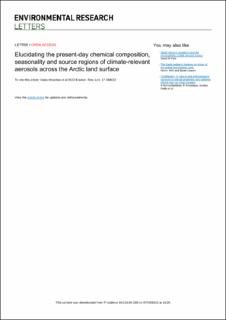Elucidating the present-day chemical composition, seasonality and source regions of climate-relevant aerosols across the Arctic land surface
| dc.contributor.author | Moschos, Vaios | |
| dc.contributor.author | Schmale, Julia | |
| dc.contributor.author | Aas, Wenche | |
| dc.contributor.author | Becagli, Silvia | |
| dc.contributor.author | Calzolai, Giulia | |
| dc.contributor.author | Eleftheriadis, Konstantinos | |
| dc.contributor.author | Moffett, Claire E. | |
| dc.contributor.author | Schnelle-Kreis, Jürgen | |
| dc.contributor.author | Severi, Mirko | |
| dc.contributor.author | Sharma, Sangeeta | |
| dc.contributor.author | Skov, Henrik | |
| dc.contributor.author | Vestenius, Mika | |
| dc.contributor.author | Zhang, Wendy | |
| dc.contributor.author | Hakola, Hannele | |
| dc.contributor.author | Hellén, Heidi | |
| dc.contributor.author | Huang, Lin | |
| dc.contributor.author | Jaffrezo, Jean-Luc | |
| dc.contributor.author | Massling, Andreas | |
| dc.contributor.author | Nøjgaard, Jacob Klenø | |
| dc.contributor.author | Petäjä, Tuukka | |
| dc.contributor.author | Popovicheva, Olga | |
| dc.contributor.author | Sheesley, Rebecca J. | |
| dc.contributor.author | Traversi, Rita | |
| dc.contributor.author | Yttri, Karl Espen | |
| dc.contributor.author | Prévôt, André S. H. | |
| dc.contributor.author | Baltensperger, Urs | |
| dc.contributor.author | El Haddad, Imad | |
| dc.date.accessioned | 2022-03-11T11:36:06Z | |
| dc.date.available | 2022-03-11T11:36:06Z | |
| dc.date.created | 2022-03-07T16:17:11Z | |
| dc.date.issued | 2022 | |
| dc.identifier.citation | Environmental Research Letters. 2022, 17, 034032. | en_US |
| dc.identifier.issn | 1748-9326 | |
| dc.identifier.uri | https://hdl.handle.net/11250/2984614 | |
| dc.description.abstract | The Arctic is warming two to three times faster than the global average, and the role of aerosols is not well constrained. Aerosol number concentrations can be very low in remote environments, rendering local cloud radiative properties highly sensitive to available aerosol. The composition and sources of the climate-relevant aerosols, affecting Arctic cloud formation and altering their microphysics, remain largely elusive due to a lack of harmonized concurrent multi-component, multi-site, and multi-season observations. Here, we present a dataset on the overall chemical composition and seasonal variability of the Arctic total particulate matter (with a size cut at 10 μm, PM10, or without any size cut) at eight observatories representing all Arctic sectors. Our holistic observational approach includes the Russian Arctic, a significant emission source area with less dedicated aerosol monitoring, and extends beyond the more traditionally studied summer period and black carbon/sulfate or fine-mode pollutants. The major airborne Arctic PM components in terms of dry mass are sea salt, secondary (non-sea-salt, nss) sulfate, and organic aerosol (OA), with minor contributions from elemental carbon (EC) and ammonium. We observe substantial spatiotemporal variability in component ratios, such as EC/OA, ammonium/nss-sulfate and OA/nss-sulfate, and fractional contributions to PM. When combined with component-specific back-trajectory analysis to identify marine or terrestrial origins, as well as the companion study by Moschos et al 2022 Nat. Geosci. focusing on OA, the composition analysis provides policy-guiding observational insights into sector-based differences in natural and anthropogenic Arctic aerosol sources. In this regard, we first reveal major source regions of inner-Arctic sea salt, biogenic sulfate, and natural organics, and highlight an underappreciated wintertime source of primary carbonaceous aerosols (EC and OA) in West Siberia, potentially associated with the oil and gas sector. The presented dataset can assist in reducing uncertainties in modelling pan-Arctic aerosol-climate interactions, as the major contributors to yearly aerosol mass can be constrained. These models can then be used to predict the future evolution of individual inner-Arctic atmospheric PM components in light of current and emerging pollution mitigation measures and improved region-specific emission inventories. | en_US |
| dc.language.iso | eng | en_US |
| dc.rights | Navngivelse 4.0 Internasjonal | * |
| dc.rights.uri | http://creativecommons.org/licenses/by/4.0/deed.no | * |
| dc.subject | Zeppelinobservatoriet | |
| dc.title | Elucidating the present-day chemical composition, seasonality and source regions of climate-relevant aerosols across the Arctic land surface | en_US |
| dc.type | Peer reviewed | en_US |
| dc.type | Journal article | en_US |
| dc.description.version | publishedVersion | en_US |
| dc.rights.holder | © Canadian 2022 Crown copyright | en_US |
| dc.source.pagenumber | 14 | en_US |
| dc.source.volume | 17 | en_US |
| dc.source.journal | Environmental Research Letters | en_US |
| dc.identifier.doi | 10.1088/1748-9326/ac444b | |
| dc.identifier.cristin | 2008130 | |
| dc.relation.project | Miljødirektoratet: * | en_US |
| dc.relation.project | EC/H2020/689443 | en_US |
| dc.relation.project | NILU: 115058 | en_US |
| dc.relation.project | NILU: 121002 | en_US |
| dc.source.articlenumber | 034032 | en_US |
| cristin.ispublished | true | |
| cristin.fulltext | original | |
| cristin.qualitycode | 2 |
Tilhørende fil(er)
Denne innførselen finnes i følgende samling(er)
-
Publikasjoner fra Cristin - NILU [1329]
-
Vitenskapelige publikasjoner [1068]
Vitenskapelige artikler, kapitler og monografier.

